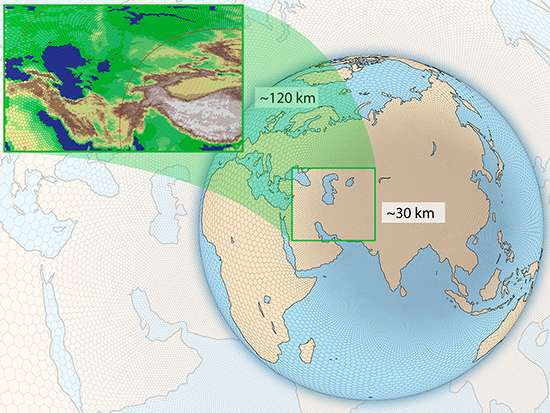Scientists decipher how local weather can change global climate patterns

Local rain in Asia might cause global splash. That's what scientists at Pacific Northwest National Laboratory (PNNL) found when they discovered connections between rain in Asia and the southern hemisphere's jet stream, an atmospheric current influencing weather across the globe.
Using advanced computational modeling, they examined local conditions and global patterns at the same time. The model zoomed in on some areas while keeping a bird's eye view in others. The study, using the variable-resolution modeling, is the first to document connections between local turbulence shifting clouds and storms (convection) and global air patterns in another hemisphere.
What happens in one corner of the globe may affect another region. Scientists are seeing this in action when it comes to weather and climate. It turns out that local rain showers can shift the jet stream and reroute the path of storms in another hemisphere. Scientists call this an "upscale" effect, similar to how the El Niño-Southern Oscillation, a years-long climate pattern over the Pacific Ocean, influences weather in the United States. Heavier rain in Asia can cause a shift of the jet stream and alter weather patterns and storminess in the southern hemisphere. Being able to model these remote connections between local to global is an important part of understanding weather and climate.
Researchers at PNNL and a collaborator at the Institute of Atmospheric Physics in China studied the upscale effects found in a global variable-resolution model (the Model for Prediction Across Scale, "MPAS"). Most of the model used a coarse level of detail, with refinements over South America, North America, and Asia.
They performed simulations that resolve extra spatial details in selected regions. Even though the regions with additional details were thousands of miles away the southern hemisphere jet stream responded by moving closer to the South Pole. One way the extra details led to the change was through Hadley Cells—a series of north-south overturning circulation where hot air rises near the equator, travels polward, cools, and then descends back to near the surface. Another pathway was through "Rossby Waves," atmospheric wave patterns caused by the rotation of the Earth.
The team found the same results in a global high-resolution simulation that maintained a high level of detail across the planet. Because of the consistency, the research suggests that a variable-resolution model produces high-quality results, without requiring the same computational time and expense. This finding provides a possible way to improve simulations of large-scale patterns and connections.
The team will test even finer resolutions in the variable-scale framework, going down to a few kilometers of detail at the center of the high-resolution region. Such high resolution allows the model to simulate atmospheric processes even more realistically, which is expected to also improve the representation of how small processes affect larger ones.
More information: Koichi Sakaguchi et al. Sources and pathways of the upscale effects on the Southern Hemisphere jet in MPAS-CAM4 variable-resolution simulations, Journal of Advances in Modeling Earth Systems (2016). DOI: 10.1002/2016MS000743
Provided by Pacific Northwest National Laboratory




















